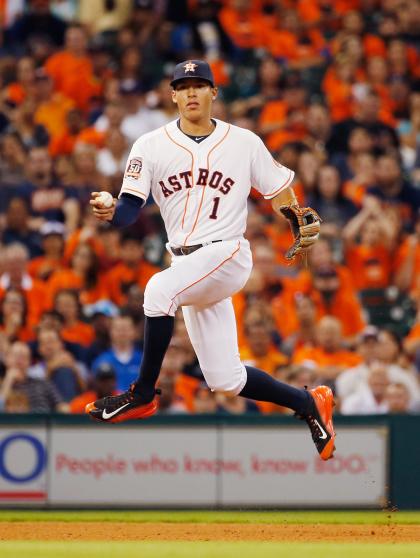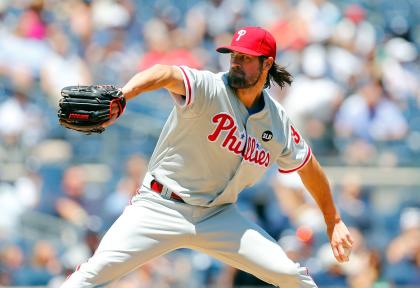Tuesdays with Brownie: Astros' young sensation impressing veteran stars
(A weekly look at the players, teams, trends, up-shoots and downspouts shaping the 2015 season.)
Carlos Correa walked straight up to Albert Pujols before batting practice in Anaheim, stuck out his hand and said, “Hi, I’m Carlos Correa,” because there’d be no better time or place to meet the man he’d looked up to since he was 5.
There’ve been others for Correa. Troy Tulowitzki, when the Houston Astros were in Colorado. There’d be more. Alex Rodriguez, when the New York Yankees were in Houston last week.
“I get compared to him a lot,” Correa said with a small blush. “So …”
“Nice kid,” Rodriguez said.
“He’s bigger than I thought,” Pujols said.

Correa is 20 years old and 20 games into his first big-league season. In early June, when Astros manager A.J. Hinch announced on the team plane that Correa would be joining the club the following day, a loud cheer erupted on the tarmac in Toronto. There were men whose jobs were suddenly at risk on that plane, and still they celebrated, because the Astros were getting better and because this seemed a good, deserving kid.
Correa singled in his second at-bat, homered in his second game, had four three-hit games in his first three weeks, and finished this past weekend’s series against the Yankees batting .314 in 89 plate appearances, and aggressively at that – three walks, 19 strikeouts.
You hear this kind of thing a lot, but here it is anyway: Correa, at 20, has conducted himself as a grown man. He can flat-out play the game. (“I like his swing,” Pujols said. “He’s the real deal.”) He has shown himself to be humble, an impressive development given his status already as a baseball hero in Puerto Rico. It takes some pluck for your 20-year-old self, a few years out of high school, to walk up to the living, breathing poster on your bedroom wall and have anything come out of your mouth that sounds like an actual word. He gave it a shot.
“It’s such an honor to play with you,” he’d told Pujols. “I’ll never take it for granted.”
The 6-foot-3 Pujols recognized the young man before him as the Astros’ young shortstop. He’d heard about him. He’d seen him a little on television. He was surprised to find himself looking slightly up at him.
“I love that,” Pujols said. “I’m sure it can be intimidating. So it makes me feel good when he can come and say hello.”
As Correa was growing up in Santa Isabel, Puerto Rico, and as his skills developed to where he went off to high school at the Puerto Rico Baseball Academy in Gurabo, he fell not for a single major league team, but for the men he hoped to emulate. Some were from Puerto Rico – Roberto Alomar Jr. for one, Ivan Rodriguez for another. And then Pujols, A-Rod, Tulo, others. He would watch them and tell his father, I want to hit like him, defend like him, be him.
“And my dad would tell me, ‘You have to work until your idols become your rivals,’ ” Correa said.
In his short time with the first-place Astros, Correa has batted .500 (9 for 18) with a home run and three RBI against Tulo’s Rockies, .286 (4 for 14) with a home run and five RBI against Pujols’ Angels, and .375 (6 for 16) with a homer and three RBI against A-Rod’s Yankees.
They’re rivals now.
“Oh, he made me feel old,” Pujols said.
Correa laughed at that.
“It’s been crazy, man,” he said. “So much fun.”
In need of a trade boost?
Regardless of how this ends for them in 2015 – be it their first division title of any kind in 14 years or something a little less satisfying – the plan is working for the Astros.
So along comes the next phase, the one that follows payroll increases from $26 million in 2013 to $72 million in 2015, that follows four years of hoarding and developing prospects, that comes from the expectations of a fan base just now tip-toeing back into the ballpark.
That is, turning some of that organizational progress into sustained relevance, and some of that long-term plan into second-half wins. And that could mean turning some of those beloved, high-ceilinged young men into a veteran pitcher or two at the trading deadline. These are the big-boy decisions, the ones Astros management promised when they stripped the roster down to 111 losses not so long ago.
After three months, the Astros’ starters are a tick below league average. Dallas Keuchel is one of the best in the game. Lance McCullers is 21 and has been terrific for eight starts. Rookie Vincent Velasquez has had his moments over four starts. The rest – Collin McHugh has been up and down and better lately, Scott Feldman is recovering from knee surgery – would demand it’s time to plan for today.
The Astros believe Cole Hamels would block a trade to Houston. (He’s also due $73.5 million over the next three seasons. It’s not impossible they are pleased with Hamels’ stance.)
So, said a source in team management, “Anybody from Johnny Cueto on down.”
That means Cueto, or Jeff Samardzija, or Scott Kazmir, or Mike Leake, or Dan Haren, or Clay Buchholz. There are upgrades out there. They’ll cost. And they’ll fly against everything the Astros have stood for going on half a decade.
It’s a big step. But this day was coming.
A familiar Miami situation
The Miami Marlins had one shot left in 2015, and that was for as many of them as possible to get roaring hot, Jose Fernandez to come back and save the rotation, and then maybe – mayyyybe – they’d make a run at something like relevance. That doesn’t happen a lot to teams that can’t hit, or to teams that pitch only once in a while, or to teams whose morale is regularly tested by the oddball moves by its front office. It especially doesn’t happen to teams that lose Giancarlo Stanton for a month or two due to a wrist injury.
Fernandez returns Thursday afternoon against the San Francisco Giants to precisely what he left – a franchise with tons of talent that can’t make it work.
Now what?
Expect the Marlins to trade Dan Haren and, if possible, Mat Latos. Their contracts expire at the end of the season. Haren has been effective in Miami, while Latos has been grossly erratic. Haren to the Dodgers (who are paying his salary, after all) makes sense. Haren to the back of anyone’s rotation makes sense.
There will be interest in Martin Prado, the veteran infielder/outfielder who comes off the disabled list this week. Presumably the Marlins would love to move Michael Morse, but he’s been hurt, been unproductive when upright, and is due $10 million through 2016. Prado also is under contract through 2016.
Few abandon a plan as earnestly and comically as the Marlins do. They say they’ll stick with this one, despite another disaster. We’ll see.
Hamels market heating up

About a half-dozen teams are engaged to some degree with the Phillies on Cole Hamels. The Chicago Cubs and New York Yankees are among them, a club source said. The Cubs have been aggressive enough that the Phillies have mobilized scouts through the Cubs’ system, as they almost certainly have for the others.
Perhaps a year or two before some believed they would be ready to win, the Cubs jumped on Jon Lester, which moved up the timeline. Sadly for the Cubs, the rotation is running a bit thin. Sadder still, Lester has been one of the problems.
Nothing is ever as easy as it looks. The Cubs at the moment aren’t as good as the Pittsburgh Pirates, aren’t anywhere near as good as the St. Louis Cardinals, there are other wild-card issues (San Francisco, New York) and if the plan was to gradually build the rotation, Lester for $155 million in December followed by Hamels for $73.5 million in July is sort of gradual.
Hamels has told reporters in Philadelphia he’d consider a trade to any team. He cannot block a trade to the Cubs, either New York team, St. Louis, Atlanta, the Los Angeles Dodgers, Washington, San Diego or Texas.
Silly Phillies
The new analytics aren’t so new anymore. They should just call them analytics from now on. Except, apparently, in Philadelphia.
It seemed odd Monday morning that new president Andy MacPhail, who is 62 and hasn’t been in the game at the club level for 3 ½ years, felt he had to speak to the advantages of analytics, like he was introducing electric razors to Vikings.
“When it comes to that sort of thing, I look at everything,” he said. “Absolutely everything.
“I am hardly the guy who is the Sabermetric genius. So you hire the guys who are.”
Huh.
This really the first the Phillies have heard of this?
More MLB coverage from Yahoo Sports:

 Yahoo Sports
Yahoo Sports 
